The Heavy Mineral Map of Australia: Vision and Pilot Project
Abstract
:1. Introduction
- Are the NGSA samples appropriate for HM identification and quantification using automated mineralogy technologies?
- Can the bulk samples be used, or must the HM fraction be physically separated first?
- Is there sufficient mineralogical diversity in the HM assemblages of a few random samples to predict varied and informative HM patterns at the national scale?
- Importantly, are those preliminary observations on HM extracted from alluvial sediments broadly compatible with the geology of their respective catchment areas?
2. Materials and Methods
3. Results and Discussion
3.1. Pilot Project
- H0090 (Murray geological region; see Figure 1) has the highest spinel concentration (0.46 vol%), an accessory mineral found in basalt, peridotite, kimberlite and marble;
- H0115 (Adelaide) is highest in harkerite (0.22), chlorite (0.28) and hematite/magnetite (10.5), minerals suggesting high-temperature contact metamorphism, low-grade metamorphic rocks, or iron-rich sedimentary or igneous rocks, respectively (thus representing a mixed terrane signature);
- H0453 (Paleozoic-Qld) is highest in cassiterite (0.16), indicative of medium- to high-temperature magmatic-hydrothermal veins or alluvial placers;
- H0602 (Yilgarn) and H1052 (Birrindudu) are second highest and highest samples in ilmenite (36.7 and 42.6, respectively), suggestive of igneous rocks or placer deposits;
- H1046 (Carpentaria) and H1337 (Arafura) are second highest and highest samples in monazite (1.90 and 2.16, respectively), a mineral typically associated with REEs enrichment; and
- H1337 is highest in zircon (42.2) whilst H1353 (Pinjarra) is second highest in zircon (31.8), a mineral suggesting an igneous or metamorphic rock affinity.
3.2. Mineral Network Analysis
- Mineral abundance: every mineral present in a sample is represented by a node (e.g., a circle), the size of which is proportional to the abundance of the mineral within the sample population;
- Mineral co-occurrence: minerals that co-occur in a sample are linked by lines (edges), the weight (or thickness) of which can be made proportional to the number of samples where this pair of minerals co-occurs.
4. The Heavy Mineral Map of Australia
5. Conclusions
- The NGSA samples contain sufficient HMs to allow their identification and quantification using automated mineralogy technologies.
- The HM fraction must be physically separated from the bulk samples prior to automated mineralogical analysis to enhance detection and sensitivity.
- The HM assemblages display high mineralogical diversity, foreshadowing the discovery of varied and informative HM patterns at the national scale.
- The identification and quantification of HMs extracted from alluvial sediments are broadly consistent with the geology and geochemistry of their respective catchment areas.
Supplementary Materials
Author Contributions
Funding
Data Availability Statement
Acknowledgments
Conflicts of Interest
References
- Morton, A.C. Heavy Minerals. In Encyclopedia of Earth Science, Sedimentology; Springer: Berlin/Heidelberg, Germany, 1978. [Google Scholar]
- Joshi, K.B.; Banerji, U.S.; Dubey, C.P.; Oliveira, E.P. Heavy minerals in provenance studies: An overview. Arab. J. Geosci. 2021, 14, 1330. [Google Scholar] [CrossRef]
- McClenaghan, M.B.; Spirito, W.A.; Day, S.J.A.; McCurdy, M.W.; McNeil, R.J.; Adcock, S.W. Overview of surficial geochemistry and indicator mineral surveys and case studies from the Geological Survey of Canada’s GEM Program. Geochem. Explor. Environ. Anal. 2022, 22, geochem2021-070. [Google Scholar] [CrossRef]
- Mackay, D.A.R.; Simandl, G.J. Pyrochlore and columbite-tantalite as indicator minerals for specialty metal deposits. Geochem. Explor. Environ. Anal. 2015, 15, 167–178. [Google Scholar] [CrossRef]
- NRC (National Research Council). Minerals, Critical Minerals, and the U.S. Economy; The National Academies Press: Washington, DC, USA, 2008. [Google Scholar]
- Gunn, G. (Ed.) Critical Metals Handbook; American Geophysical Union Publication, British Geological Survey; John Wiley & Sons: Nottingham, UK, 2014. [Google Scholar]
- Cobelo-García, A.; Filella, M.; Croot, P.; Frazzoli, C.; Du Laing, G.; Ospina-Alvarez, N.; Rauch, S.; Salaun, P.; Schäfer, J.; Zimmermann, S. COST action TD1407: Network on technology-critical elements (NOTICE)—From environmental processes to human health threats. Environ. Sci. Pollut. Res. 2015, 22, 15188–15194. [Google Scholar] [CrossRef] [Green Version]
- Svendsen, J.B.; Hartley, N.R. Synthetic heavy mineral stratigraphy: Applications and limitations. Mar. Pet. Geol. 2002, 19, 389–405. [Google Scholar] [CrossRef]
- Zeegers, H.; Leduc, C. Geochemical exploration for gold in temperate, arid, semi-arid, and rain-forest terrains. In Gold Metallogeny and Exploration; Foster, R.P., Ed.; Springer: Dordrecht, The Netherlands, 1993. [Google Scholar] [CrossRef]
- Muggeridge, M.T. Pathfinder sampling techniques for locating primary sources of diamond: Recovery of indicator minerals, diamonds and geochemical signatures. J. Geochem. Explor. 1995, 53, 183–204. [Google Scholar] [CrossRef]
- Nowicki, T.E.; Moore, R.O.; Gurney, J.J.; Baumgartner, M.C. Diamonds and Associated Heavy Minerals in Kimberlite: A Review of Key Concepts and Applications. Dev. Sedimentol. 2007, 58, 1235–1267. [Google Scholar] [CrossRef]
- Barnett, P.J.; Averill, S. Heavy mineral dispersal trains in till in the area of the Lac des Iles PGE deposit, northwestern Ontario, Canada. Geochem. Explor. Environ. Anal. 2010, 10, 391–399. [Google Scholar] [CrossRef]
- Evans, N.J.; McInnes, B.I.A.; McDonald, B.J.; Danišík, M.; Jourdan, F.; Mayers, C.; Thern, E.; Corbett, D. Emplacement age and thermal footprint of the diamondiferous Ellendale E9 lamproite pipe, Western Australia. Miner. Deposita 2013, 48, 413–421. [Google Scholar] [CrossRef]
- McClenaghan, M.B.; Parkhill, M.A.; Seaman, A.A.; Pronk, A.G.; McCurdy, M.; Kontak, D.J. Overview of Tungsten Indicator Minerals Scheelite and Wolframite with Examples from the Sisson W-Mo deposit, Canada. In Application of Indicator Mineral Methods to Mineral Exploration, Short Course SC07, Proceedings of the 26th Int App Geoch Symp, Rotorua, New Zealand, 18–21 November 2013; Available online: https://www.appliedgeochemists.org/images/stories/IAGS_2013/10-McClenaghan-etal.pdf (accessed on 28 July 2022 ).
- O’Brien, J.J.; Spry, P.G.; Teale, G.S.; Jackson, S.E.; Koenig, A.E. Gahnite composition as a means to fingerprint metamorphosed massive sulfide and non-sulfide zinc deposits. J. Geochem. Explor. 2015, 159, 48–61. [Google Scholar] [CrossRef] [Green Version]
- Taivalkoski, A.; Sarala, P.; Hulkki, H. Gold exploration using heavy minerals in till and weathered bedrock in Petäjäselkä, northern Finland. Geochem. Explor. Environ. Anal. 2015, 15, 205–221. [Google Scholar] [CrossRef]
- Salama, W.; Anand, R.R.; Verrall, M. Mineral exploration and basement mapping in areas of deep transported cover using indicator heavy minerals and paleoredox fronts, Yilgarn Craton, Western Australia. Ore Geol. Rev. 2016, 72, 485–509. [Google Scholar] [CrossRef]
- Mao, M.; Rukhlov, A.S.; Rowins, S.M.; Hickin, A.S.; Ferbey, T.; Bustard, A.; Spence, J.; Coogan, L.A. A Novel Approach Using Detrital Apatite and Till Geochemistry to Identify Covered Mineralization in the TREK Area of the Nechako Plateau, British Columbia. In Indicator Minerals in Till and Stream Sediments of the Canadian Cordillera; Ferbey, T., Plouffe, A., Hickin, A.S., Eds.; Topics in Mineral Sciences; Mineral Association Canada: Toronto, ON, Canada, 2017; Volume 47, pp. 191–243. ISBN 978-0-921294-60-3. Available online: https://gac.ca/product/indicator-minerals-in-till-and-stream-sediments-of-the-canadian-cordillera-a-joint-publication-of-gac-and-mac/ (accessed on 28 July 2022 ).
- Xing, Y.; Brugger, J.; Tomkins, A.; Shvarov, Y. Arsenic evolution as a tool for understanding formation of pyritic gold ores. Geology 2019, 47, 335–338. [Google Scholar] [CrossRef]
- Krneta, S.; Ciobanu, C.L.; Cook, N.J.; Ehrig, K.; Kontonikas-Charos, A. Rare earth element behaviour in apatite from the Olympic Dam Cu-U-Au-Ag deposit, South Australia. Minerals 2017, 7, 135. [Google Scholar] [CrossRef] [Green Version]
- Mao, M.; Rukhlov, A.S.; Rowins, S.M.; Spence, J.; Coogan, L.A. Apatite Trace Element Compositions: A Robust New Tool for Mineral Exploration. Econ. Geol. 2016, 111, 1187–1222. [Google Scholar] [CrossRef]
- Lu, Y.-J.; Loucks, R.R.; Fiorentini, M.; McCuaig, T.C.; Evans, N.J.; Yang, Z.-M.; Hou, Z.-Q.; Kirkland, C.L.; Parra-Avila, L.A.; Kobussen, A. Zircon compositions as a pathfinder for porphyry Cu ± Mo ± Au deposits. Econ. Geol. 2016, Spec Pub 19, 329–347. [Google Scholar] [CrossRef]
- Pisiak, L.K.; Canil, D.; Lacourse, T.; Plouffe, A.; Ferbey, T. Magnetite as an Indicator Mineral in the Exploration of Porphyry Deposits: A Case Study in Till near the Mount Polley Cu-Au Deposit, British Columbia, Canada. Econ. Geol. 2017, 112, 919–940. [Google Scholar] [CrossRef] [Green Version]
- Cooke, D.R.; Wilkinson, J.J.; Baker, M.; Agnew, P.; Phillips, J.; Chang, Z.; Chen, H.; Wilkinson, C.C.; Inglis, S.; Hollings, P.; et al. Using Mineral Chemistry to Aid Exploration: A Case Study from the Resolution Porphyry Cu-Mo Deposit, Arizona. Econ. Geol. 2020, 115, 813–840. [Google Scholar] [CrossRef]
- Porter, J.K.; McNaughton, N.J.; Evans, N.J.; McDonald, B.J. Rutile as a pathfinder for metals exploration. Ore Geol. Rev. 2020, 120, 103406. [Google Scholar] [CrossRef]
- Lee, R.G.; Plouffe, A.; Ferbey, T.; Hart, C.J.R.; Hollings, P.; Gleeson, S.A. Recognizing porphyry copper potential from till zircon composition: A case study from the highland valley porphyry district, south-central British Columbia. Econ. Geol. 2021, 116, 1035–1045. [Google Scholar] [CrossRef]
- McInnes, B.I.A. Application of Innovative Geochronology Techniques in Geoscience Mapping and Exploration. Geol. Surv. West Austral. Rec. 2019, 2, 20–22. Available online: https://geodocsget.dmirs.wa.gov.au/api/GeoDocsGet?filekey=f6fbf3db-3ee0-4f2a-8253-c03fdadc1b7b-ogtgkscesv89cmfalodtvwjv3svwe2ioma1zk6ik (accessed on 28 July 2022 ).
- Kerr, D.E.; Kjarsgaard, I.M.; Smith, D. Chemical characteristics of kimberlite indicator minerals from the Drybones Bay area (NTS 85I/4), Northwest Territories. Geol. Surv. Can. Open File Rep. 2000, 3942, 29. [Google Scholar] [CrossRef]
- McClenaghan, M.B.; McMartin, I.; Plouffe, A. Base and Precious Metal Indicator Mineral Research at the Geological Survey of Canada. Explore 2008, 138, 12–15. Available online: https://www.appliedgeochemists.org/images/Explore/Explore,%20Number%20138%20March%202008.pdf (accessed on 28 July 2022 ).
- McClenaghan, M.B.; Plouffe, A.; Paulen, R.C.; Houlé, M.G.; Jackson, S.E.; Peter, J.M. Overview of Indicator Mineral Research at the Geological Survey of Canada—An Update. Explore 2016, 170, 1–15. Available online: https://www.appliedgeochemists.org/images/Explore/Explore_Number_170_March_2016.pdf (accessed on 28 July 2022 ).
- Hutchison, M.T. Diamond Exploration and Prospectivity of Western Australia. Geol. Surv. West Austral. Rep. 2018, 179, 70. Available online: https://geodocsget.dmirs.wa.gov.au/api/GeoDocsGet?filekey=71d9f394-cee1-4ce6-b44d-907db17b1d96-fnya03nc0udip8vfxvrilirssm4kxgt6axdga3oy (accessed on 28 July 2022 ). [CrossRef]
- Montsion, R.M.; Saumur, B.M.; Acosta-Gongora, P.; Gadd, M.G.; Tschirhart, P.; Tschirhart, V. Knowledge-driven mineral prospectivity modelling in areas with glacial overburden: Porphyry Cu exploration in Quesnellia, British Columbia, Canada. Appl. Earth Sci. 2019, 128, 181–196. [Google Scholar] [CrossRef] [Green Version]
- Caritat, P.d.; Cooper, M. National Geochemical Survey of Australia: The Geochemical Atlas of Australia. Geosci. Austral. Rec. 2011, 20, 557. Available online: http://pid.geoscience.gov.au/dataset/ga/71973 (accessed on 28 July 2022 ).
- Blake, D.; Kilgour, B. Geological Regions of Australia 1:5,000,000 Scale; Geoscience Australia: Canberra, Australia, 1998. Available online: http://pid.geoscience.gov.au/dataset/ga/32366 (accessed on 28 July 2022 ).
- Aylmore, M.G.; Merigot, K.; Quadir, Z.; Rickard, W.D.A.; Evans, N.G.; McDonald, B.J.; Catovic, E.; Spitalny, P. Applications of advanced analytical and mass spectrometry techniques to the characterisation of micaceous lithium-bearing ores. Miner. Eng. 2018, 116, 182–195. [Google Scholar] [CrossRef]
- Schulz, B.; Sandmann, D.; Gilbricht, S. SEM-Based Automated Mineralogy and its Application in Geo- and Material Sciences. Minerals 2020, 10, 1004. [Google Scholar] [CrossRef]
- Roswell, M.; Dushoff, J.; Winfree, R. A conceptual guide to measuring species diversity. Oikos 2021, 130, 321–338. [Google Scholar] [CrossRef]
- Hazen, R.M.; Grew, E.S.; Downs, R.T.; Golden, J.; Hystad, G. Mineral ecology: Chance and necessity in the mineral diversity of terrestrial planets. Can. Miner. 2015, 53, 295–324. [Google Scholar] [CrossRef]
- Hughes, A. Australian Operating Mines Map 2019, 20th ed.; Scale 1:7,000,000; Geoscience Australia: Canberra, Australia, 2020. Available online: http://pid.geoscience.gov.au/dataset/ga/133033 (accessed on 28 July 2022 ).
- Sexton, M. Australian Mineral Occurrences Collection; Geoscience Australia: Canberra, Australia, 2011. Available online: http://pid.geoscience.gov.au/dataset/ga/73131 (accessed on 28 July 2022 ).
- Morrison, S.M.; Liu, C.; Eleish, A.; Prabhu, A.; Li, C.; Ralph, J.; Downs, R.T.; Golden, J.J.; Fox, P.; Hummer, D.R.; et al. Network analysis of mineralogical systems. Am. Miner. 2017, 102, 1588–1596. [Google Scholar] [CrossRef]
- Chang, W.; Cheng, J.; Allaire, J.J.; Sievert, C.; Schloerke, B.; Xie, Y.; Allen, J.; McPherson, J.; Dipert, A.; Borges, B. Shiny: Web Application Framework for R; R Package Version 1.7.1. 2021. Available online: https://CRAN.R-project.org/package=shiny (accessed on 28 July 2022 ).
- Fruchterman, T.M.J.; Reingold, E.M. Graph drawing by force-directed placement. Softw. Pract. Exp. 1991, 21, 1129–1164. [Google Scholar] [CrossRef]
- Almende, B.V.; Thieurmel, B.; Titouan, R. visNetwork: Network Visualization Using ‘vis.js’ Library; R Package Version 2.1.0. 2021. Available online: https://CRAN.R-project.org/package=visNetwork (accessed on 28 July 2022 ).
- Csardi, G.; Nepusz, T. The Igraph Software Package for Complex Network Research. InterJ. Complex Syst. 2006, 1695. Available online: https://igraph.org (accessed on 28 July 2022 ).
- Skirrow, R.G.; Murr, J.; Schofield, A.; Huston, D.L.; van der Wielen, S.; Czarnota, K.; Coghlan, R.C.; Highet, L.M.; Connolly, D.; Doublier, M.; et al. Mapping iron oxide Cu-Au (IOCG) mineral potential in Australia using a knowledge-driven mineral systems-based approach. Ore Geol. Rev. 2019, 113, 103–120. [Google Scholar] [CrossRef]
- Ottesen, R.T.; Bogen, J.; Bølviken, B.; Volden, T. Overbank sediment: A representative sampling medium for regional geochemical mapping. J. Geochem. Explor. 1989, 32, 257–277. [Google Scholar] [CrossRef]
- Caritat, P.d.; Cooper, M. A continental-scale geochemical atlas for resource exploration and environmental management: The National Geochemical Survey of Australia. Geoch. Explo. Env. Anal. 2016, 16, 3–13. [Google Scholar] [CrossRef]
- Caritat, P.d.; Dosseto, A.; Dux, F. A strontium isoscape of inland southeastern Australia. Earth Syst. Sci. Data Discuss. 2022, 1–23, preprint, in review. [Google Scholar]
- Desem, C.U.; Maas, R.; Woodhead, J.; Carr, G.; Caritat, P.d. Towards a Pb isotope regolith map of the Australian continent: A Northern Territory perspective. In Exploring for the Future: Extended Abstracts; Czarnota, K., Roach, I., Abbott, S., Haynes, M., Kositcin, N., Ray, A., Slatter, E., Eds.; Geoscience Australia: Canberra, Australia, 2020. [Google Scholar] [CrossRef]
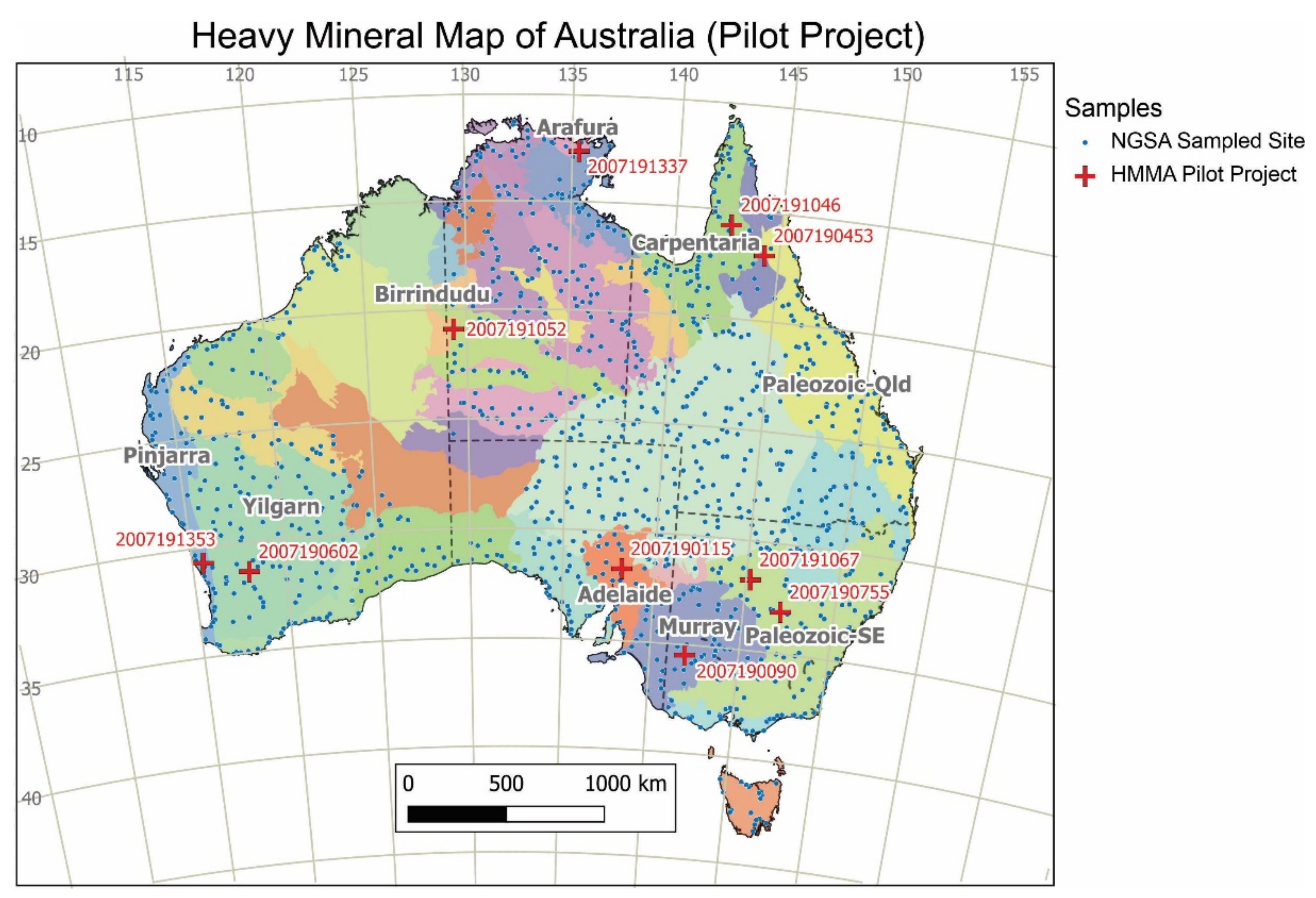
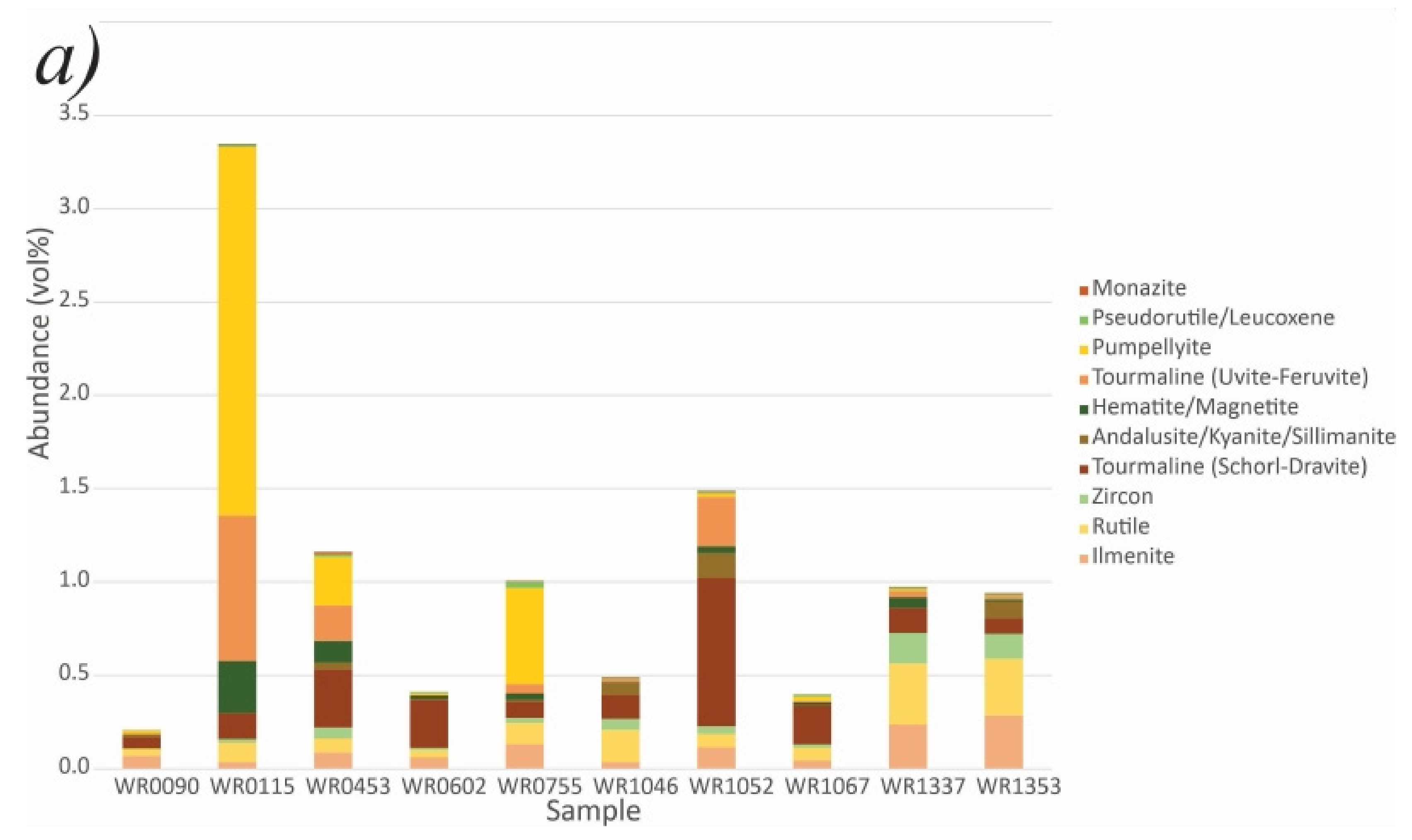

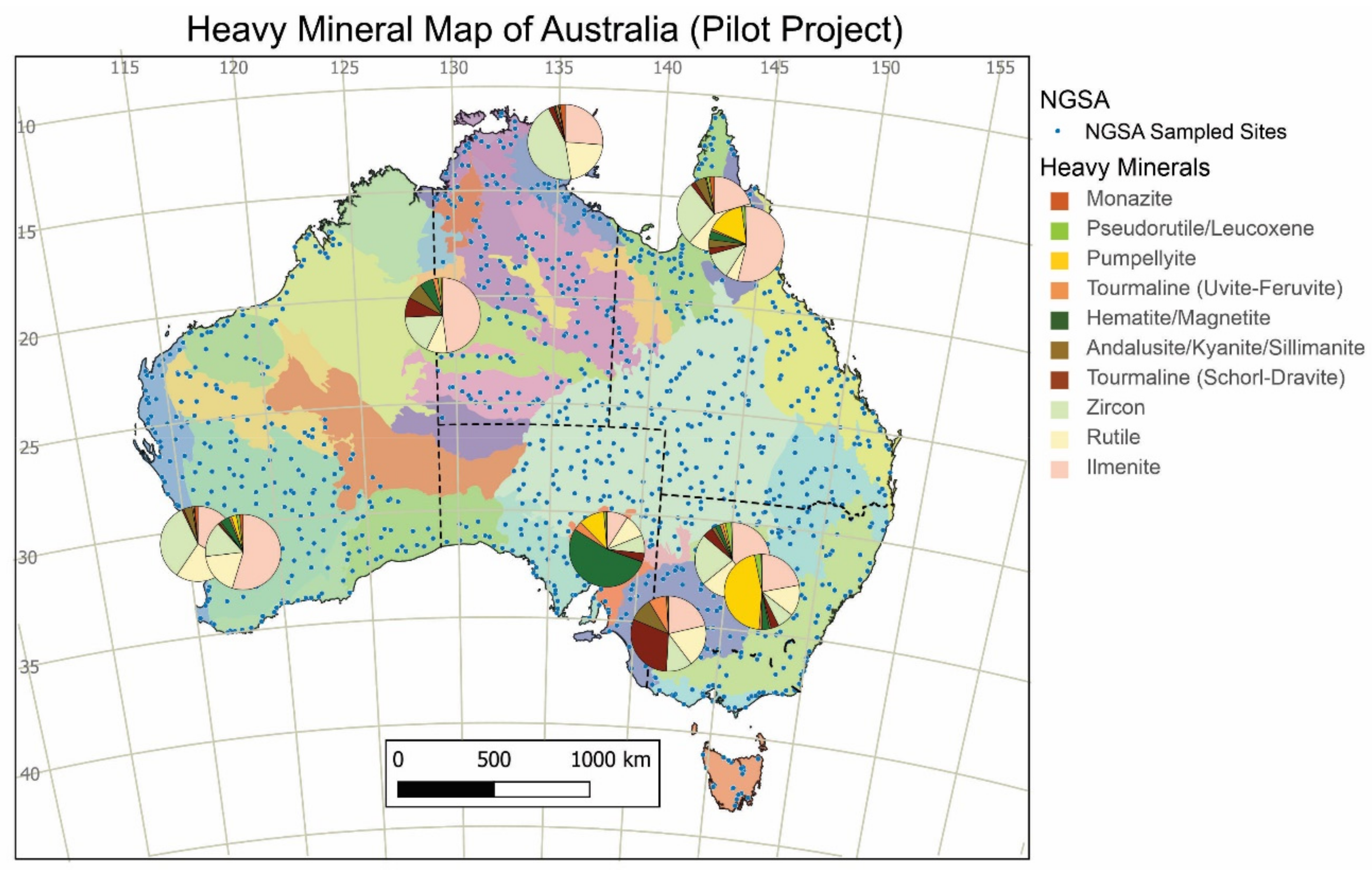
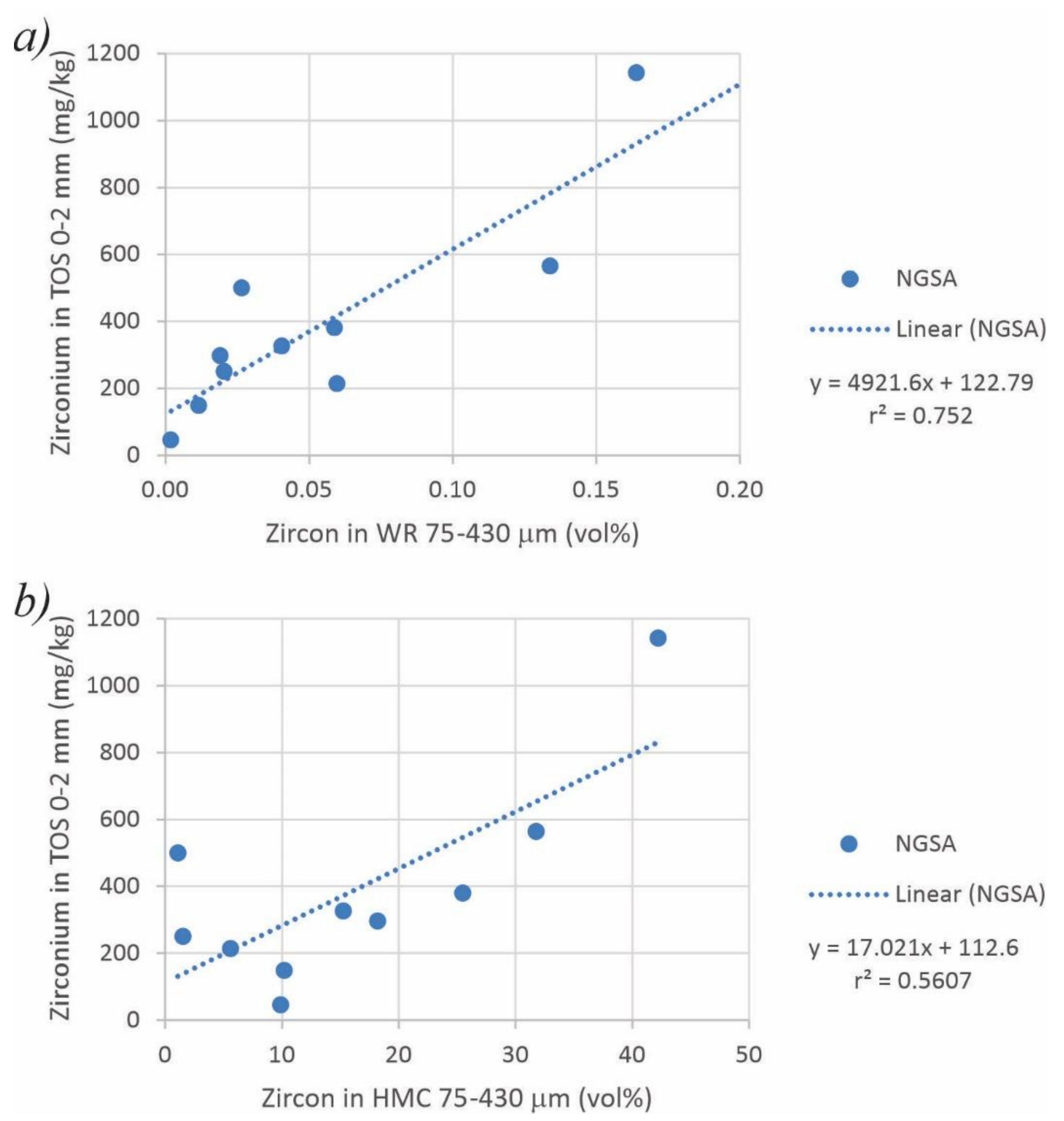
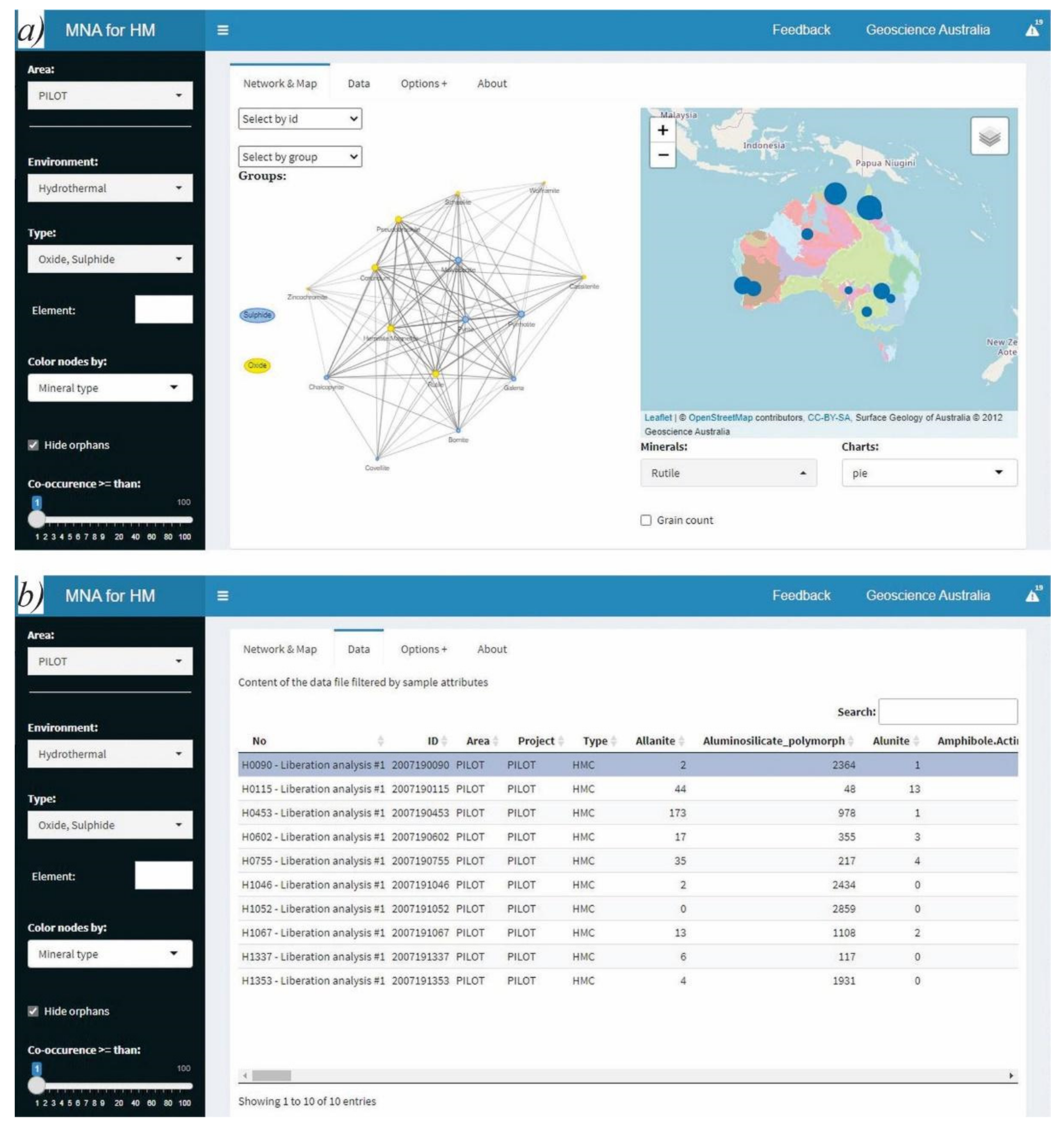
Publisher’s Note: MDPI stays neutral with regard to jurisdictional claims in published maps and institutional affiliations. |
© 2022 by the authors. Licensee MDPI, Basel, Switzerland. This article is an open access article distributed under the terms and conditions of the Creative Commons Attribution (CC BY) license (https://creativecommons.org/licenses/by/4.0/).
Share and Cite
Caritat, P.d.; McInnes, B.I.A.; Walker, A.T.; Bastrakov, E.; Rowins, S.M.; Prent, A.M. The Heavy Mineral Map of Australia: Vision and Pilot Project. Minerals 2022, 12, 961. https://doi.org/10.3390/min12080961
Caritat Pd, McInnes BIA, Walker AT, Bastrakov E, Rowins SM, Prent AM. The Heavy Mineral Map of Australia: Vision and Pilot Project. Minerals. 2022; 12(8):961. https://doi.org/10.3390/min12080961
Chicago/Turabian StyleCaritat, Patrice de, Brent I. A. McInnes, Alexander T. Walker, Evgeniy Bastrakov, Stephen M. Rowins, and Alexander M. Prent. 2022. "The Heavy Mineral Map of Australia: Vision and Pilot Project" Minerals 12, no. 8: 961. https://doi.org/10.3390/min12080961
APA StyleCaritat, P. d., McInnes, B. I. A., Walker, A. T., Bastrakov, E., Rowins, S. M., & Prent, A. M. (2022). The Heavy Mineral Map of Australia: Vision and Pilot Project. Minerals, 12(8), 961. https://doi.org/10.3390/min12080961





